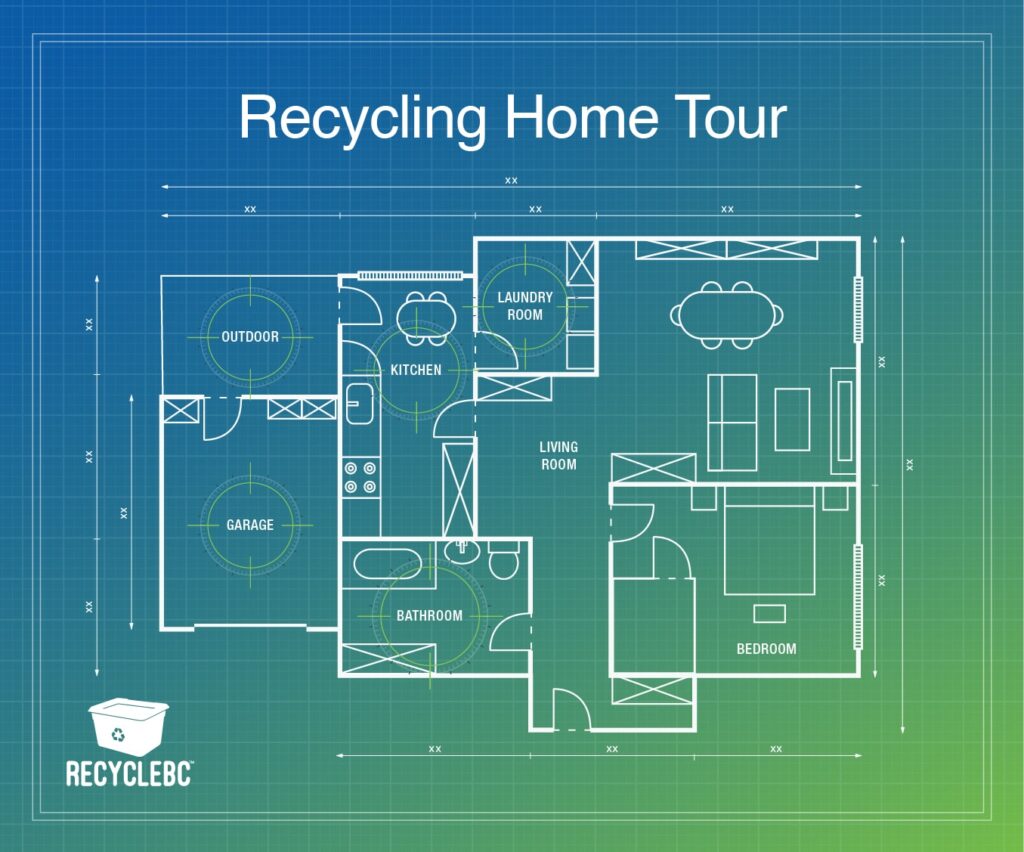Page contents:
Recycle BC is launching a campaign encouraging British Columbians to use their time at home during the COVID-19 pandemic to become better recyclers. The online campaign takes residents room-by-room and item-by-item, helping them identify the residential packaging and paper people are least likely to recycle, based on a survey of 1,000 residents.
“Most people have been home for a few weeks now, and we are hoping those who are healthy and looking for something to do will take a moment, maybe on their lunch break or weekend, to review all of the opportunities we have identified,” said David Lefebvre, Recycle BC’s Director of Public Affairs. “We know British Columbians take their recycling seriously. We hope this campaign will help them take their recycling efforts to the next level.”
By highlighting materials that are accepted in the Recycle BC program, the survey found residents are still throwing out some items when they could be recycled. Respondents reported the highest recycling rates for paper products, while glass jars and plastic packaging was lower. All rooms throughout the house presented opportunities for people to increase the items they recycle. The easiest ones included:
Bathroom
- 33 per cent throw away metal aerosol containers (e.g. hair spray, air freshener)
- 21 per cent throw away metal containers (e.g. hair product, hand cream)
- 13 per cent throw away hard plastic containers (e.g. shampoo and mouthwash)
Kitchen
- 23 per cent throw away spiral wound cans and metal lids (e.g. frozen fruit juice, chips, cookie dough)
- 17 per cent throw away non-deposit cartons (e.g. soup, ice cream, chicken stock)
Laundry room
- 30 per cent throw away aerosol metal containers (e.g. air freshener, disinfectant)
- 21 per cent throw away metal containers (e.g. laundry detergent, shoe polish)
Garage and outdoor area
- 14 per cent throw away hard plastic packaging (e.g. tools and windshield wipers packaging)
- 10 per cent throw away plastic plant pots.
All of these items are very easy to recycle as residents can include them in their curbside recycling collection. In addition, the survey found many residents are not returning depot-only materials, like plastic bags and foam packaging, as often as they could. Residents either throw them in the garbage or put them in their curbside recycling, which is not permitted and can affect the environmental performance of recycling. Specific, room-by-room findings can be found on the Recycle BC website here.
The survey provided interesting insights into why people are not recycling as much as they could be. Nearly three quarters (72 per cent) of respondents indicated they were not sure if the items are accepted in the Recycle BC program, and nearly a quarter said it was “too gross” as a result of old food or product in it.
“We want to empower people to recycle more by providing information on our website and encouraging people to download the Recycle BC app, where residents can easily search a variety of products and determine what can be recycled and how,” Lefebvre said. “This is something families can do while they are at home together. We are inviting people to follow our social media channels and follow along each day as we explore a different room in their homes and the recycling possibilities.”
Recycle BC is launching the information campaign online this week on its website and social media channels: Instagram, Facebook and Twitter. The campaign will also direct British Columbians to RecycleBC.ca/HomeTour for complete listings of what can be recycled and how.
Take the Home Tour
- Download the Recycle BC Home Tour media release
- Download the Recycle BC Home Tour backgrounder
- Download the Recycle BC Home Tour Bathroom video
Backgrounder
Recycle BC’s Recycling Home Tour
The Home Tour campaign is informed by a 15-minute online survey conducted by AHA! Marketing Insights on behalf of Recycle BC between November 28 and December 19, 2019. The survey found more than 95 per cent of British Columbians initially believed they are recycling all possible paper, cardboard, and plastic containers. However, once the survey dug a bit deeper, it found recycling rates are actually much lower with some items. The most common reason cited for not recycling an item was being unsure whether it is recyclable.
Room by room, the survey found some easily-recyclable items most often thrown away include (note: material type percentages vary based on the location within the house and type of product):
Bathroom:
- Metal aerosol containers – 33 per cent of people throw away metal aerosol containers (e.g. hair spray and sunscreen).
- Metal containers – 21 per cent of people throw away metal containers (e.g. hair products).
- Hard plastic containers – 13 per cent of people throw away hard plastic containers (e.g. pill bottles and shampoo containers).
- Paper products – 9 per cent of people throw away paper products (e.g. toilet paper tubes, soap boxes, and tissue boxes).
Kitchen:
- Spiral wound cans – 23 per cent of people throw away spiral wound cans (e.g. orange juice, ready-to-bake bread or cookie dough, and some chips). These can be rinsed and placed in the curbside bin.
- Cartons that don’t have a deposit – 17 per cent of people throw away cartons (e.g. ice cream, soup, or chicken stock). These can be rinsed and placed in the curbside bin.
- Plastic clamshells – 12 per cent of people throw away plastic clamshells (e.g. takeout food, produce or baked goods). These can be rinsed of any food waste and placed in the curbside bin.
Laundry room:
- Metal aerosol containers – 30 per cent of people throw away metal aerosol containers (e.g. air freshener and disinfectant). These containers can be placed in the curbside bin, once fully empty. If not fully emptied aerosol cans may explode during collection and processing.
- Metal containers – 21 per cent of people throw away metal containers (e.g. laundry detergent and shoe polish).
- Spiral wound containers – 20 per cent of people throw away spiral wound containers (cleaning products).
- Hard plastic containers – 11 per cent of people throw away hard plastic containers (e.g. laundry detergent and fabric softener).
Garage/outdoor:
- Hard plastic packaging – 14 per cent of people report throwing away hard plastic packaging (e.g. tools and windshield wiper packaging).
- Plastic pails – 11 per cent of people throw away plastic pails and similar items at the end of their useful life (e.g. driveway salt, cat litter).
- Plant pots – 10 per cent of people throw away plastic plant pots. These can be easily recycled by rinsing out any dirt and then placing them in the bin for curbside pickup.
All of the above materials can be easily rinsed (if required) and simply placed in the bin for curbside pickup.
Some items cannot be placed in the bin for curbside collection because they can affect environmental outcomes. For instance, foam placed in the curbside collection bin can break apart in the collection vehicle and contaminate other materials. For this reason, Recycle BC encourages British Columbians to store such materials until it is convenient to drop them off at a nearby depot – often the same depots that accept electronics and containers with a deposit (e.g. beverage containers).
Depot-only materials:
- Crinkly plastic packaging – 57 per cent of people reported throwing away crinkly plastic materials (e.g. chip bags).
- Stand up and zipper lock pouches – 43 per cent of people report throwing these away (e.g. nuts, granola, frozen berries, dishwasher pods, and soap refills).
- Plastic overwrap – 49 per cent of people report throwing these away (e.g. plastic wrapping around flats of water, toilet paper, paper towels).
- Foam packaging – 38 per cent of people report throwing this away (e.g. fresh meat trays).
The survey asked British Columbians to list the top reasons why they are not recycling some items at home.
Top reasons British Columbians identified for not recycling items:
- 72 per cent said they are ‘not sure if it’s accepted for recycling.’
- 27 per cent said they reuse recyclable materials, in particular plastic bags.
- 24 per cent said they throw out items with old food or product on them because they don’t want to clean them.
- 15 per cent said they throw out items if they are unsure how to sort them.
- 11 per cent said it was ‘too much trouble’ or inconvenient to take an item to a depot.
For the survey, AHA! Marketing Insights interviewed a sample of 1,000 B.C. residents online, with regional and demographic quotas to approximate census distribution. The precision for online polls is measured using a Credibility Interval, which for this survey is 3.5%. The data was weighted as appropriate to British Columbia population data. Statistical margins of error are not applicable to online surveys. All sample surveys may be subject to other sources of error, including but not limited to coverage error and measurement error.



